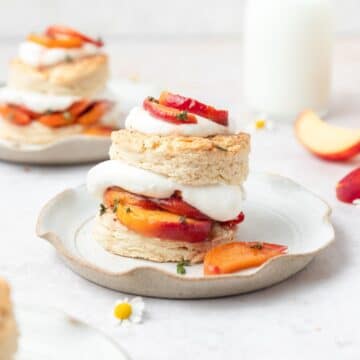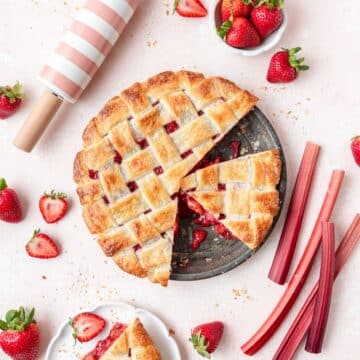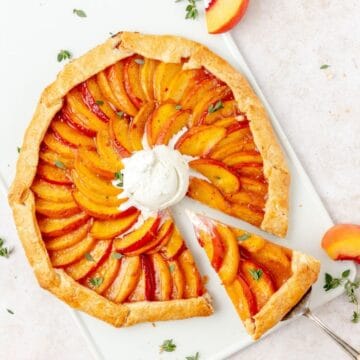This bourbon peach pie has a flaky brown butter pie crust and is filled with sweet, spiced peaches. Top with vanilla ice cream for the perfect summer dessert!

Jump to:
Why This Recipe Works
Peach pie is a classic southern recipe that's served every summer! But with just a few small modifications, I promise this will be the most flavorful peach pie you've ever had!
We use brown butter in the homemade pie crust for an extra toasty, depth of flavor that pairs beautifully with spiced peaches. And the pie filling is spiced up with bourbon, cinnamon, and nutmeg!
You might also like this classic cherry pie or my favorite apple pie!

Ingredient Notes
You just need a few simple ingredients to make the best bourbon peach pie!


Homemade Pie Crust - I use a variation of my homemade flaky pie crust with brown butter for this peach pie, but you can use whatever homemade pie crust you prefer.
Brown Butter - My favorite ingredient of all time is brown butter!! Brown butter is just unsalted butter that has been melted and gently cooked to bring out a toasty, nutty flavor. If you've never made brown butter before, you can check out this post with all my tips for how to make brown butter!
Peaches - I always use fresh peaches if I can find them, but frozen peaches work great too! You just may have to cook the filling a few minutes longer.
Cornstarch - We use cornstarch to help thicken the filling, but you can also substitute flour or clear jel. This is a great guide for making those substitutions!
Sugar - You can use either granulated sugar or light brown sugar for this peach pie!
Bourbon - This is optional but I just love the extra flavor that bourbon adds to the spiced peaches!
The complete list of ingredients and amounts is located in the recipe card below.
Peach Pie Filling
I think we can all agree that runny, soggy fruit pies are the worst! My number one tip for making sure your peach pie isn't runny, is to pre-cook the filling! It only takes about 15 minutes and makes all the difference! You can also make the filling a day or two ahead of time and just keep it in the fridge until you're ready to assemble.
This recipe was developed using fresh peaches, but you can also use frozen sliced peaches if that's all you can find. However, if you use frozen peaches, you definitely need to pre-cook the filling!
In a large pot over medium heat, combine the sliced peaches, sugar, cornstarch, lemon juice, cinnamon, nutmeg, salt, and butter.


Cook, stirring frequently, until the peaches are soft and the filling starts to simmer and thicken, about 10 minutes.
Remove from the heat and stir in the bourbon.

Allow to cool completely to room temperature before filling the pie crust.
Brown Butter Pie Crust
For more tips and tricks on how to make perfect flaky pie crust, check out this post!
Chill the brown butter until solid, then cut into small chunks.

In a medium sized bowl, whisk together the flour, sugar, and salt. Add in the cold, brown butter and use your hands to press it into the flour mixture until you get pea sized crumbs.


Add cold water and combine until dough forms a nice ball but is still slightly sticky.
Take the formed ball of dough and separate into 2 equal sections and shape into slightly flattened disks. Wrap the disks in plastic wrap and chill in the fridge for at least 30 minutes. This is important to keep the butter from melting so that the crust will be nice and flaky. The chilled dough is also much easier to work with for rolling out and creating designs.


Assemble the Pie
Once the pie dough is chilled and the filling is cooled, you can assemble the pie!
Lightly flour your counter-top and roll out half of the brown butter pie dough to ¼ inch thick and about 2 inches wider than your pie pan. Roll the pie crust into the pie pan and cut away any excess crust.
Then roll out the top crust and cut into 1 inch wide strips (or keep it in one piece, you do you).


Pour the cooled peach filling into the bottom crust and top with the strips in a lattice pattern. Be sure to seal and crimp the edges together. Place the pie back in the fridge to chill again while the oven is heating.


Let the pie chill in the fridge for about 20 minutes before baking. While the pie is chilling, preheat the oven to 425°F.
Before baking, lightly brush the top of the crust with egg wash and sprinkle with sugar if desired.
Bake at 425°F for 20 minutes. Then reduce the heat to 375°F for 30-40 minutes or until the crust is golden brown and the filling is bubbly. If the edges of the crust start to get too brown, cover with aluminum foil for the remainder of baking.

For best results, let the pie cool completely before serving to let the filling fully set.
Serve the bourbon peach pie with vanilla ice cream or homemade whipped cream and enjoy!

Tips for the Best Pie!
For all my pie recipes, I like to use my classic flaky pie crust! I have a whole blog post with tons of tips and tricks for perfect pie crust, but the most important are listed below. Be sure to check out the rest of our pie recipes too!
Keep it cold! The secret to a super flaky pie crust is keeping the dough cold at every step. Use cold butter and cold water while making the dough, and try to keep the dough as cold as possible while working with it. I often refrigerate my pies for at least 10-20 minutes after each step so that the dough stays as cold as possible. You want very cold dough going into a very hot oven for the best results!
Use a metal pie pan! Not all pie pans are created equal! Most pie pans on the market are either metal, glass, or ceramic. Overall, metal pie pans are the best of the best because they keep the crust very crispy and they're also the most durable and affordable. A fun alternative to classic aluminum pie pans that yields the same results is a cast iron skillet! I know ceramic pie plates certainly are pretty, but unfortunately the bottom crust just never gets crispy so I just don't recommend them.
Brush the crust with egg wash before baking! Brushing the crust with an egg was (just a beaten whole egg) before baking, gives a beautiful, glossy, golden brown appearance! For savory pies I like to sprinkle with flaky sea salt and for dessert pies I like to sprinkle with sparkling sugar.
Par bake for extra crispy crust! For pies with more runny fillings (like a berry pie or custard based pie), par baking the crust before filling helps ensure a super crispy bottom! It also helps prevent overcooking the filling. Place a piece of parchment paper or heavy duty aluminum foil inside the pie crust and fill with pie weights. Bake at 425°F for 15 minutes. Carefully lift the parchment paper and pie weights then return the pie crust to the oven to bake for another 5 minutes or until the bottom of the crust is just beginning to brown. [Note: unfortunately this won't work with double crust pies]
Let it rest! Letting the pie rest for a bit after removing from the oven helps the filling thicken up and prevents a runny pie. For pies that you want to eat immediately while they're still hot, it's still best to let it rest for 20-30 minutes before cutting so that the filling can thicken up slightly. But for fruit pies or custard pies, letting the pie rest for at least 4-6 hours is ideal!

Recipe FAQ's
This peach pie is best eaten the same day, but will keep covered in the fridge for up to 3 days. To reheat, bake at 350°F for 10-15 minutes or until heated through.
Up to you! I usually leave the peels on because I don't mind the texture, but if you prefer you can definitely peel them first!
This happens when the pie isn't cooked long enough, or there wasn't enough thickening agent added. But if you pre-cook the filling, you'll never have a runny pie again!

Tips for Success!
For best results I always recommend using weight measurements (especially when baking) because it's the most accurate. Kitchen scales are super affordable and also reduce the number of dishes you have to do! However, all my recipes also include US customary measurements for convince. Use this chart to convert measurements for common ingredients!
Substitutions: In all my recipes, I've included substitutions that I know will work, but I cannot guarantee results if you substitute ingredients that I have not recommended. [For example, granulated sugar and honey are indeed both sweeteners but they have very different properties so they can not always be swapped 1:1. Using honey in a cookie recipe that calls for granulated sugar will yield a giant mess.] In the recipe card you'll find links to the specific ingredients/brands that I use.
A note on salt: I almost exclusively use Diamond Crystal Kosher Salt because it's the best all-purpose salt for cooking and baking. If you're not using kosher salt, consult this handy guide for a conversion chart! When in doubt, if you're using table salt just reduce the amount by half for baked goods. When cooking, I prefer to under-salt because you can always add more! If you've over-salted, adding a little bit of acid (like lemon juice) can help.
More Recipes You Might Like!
If you make this recipe, please leave a star rating at the bottom of the page! This provides helpful feedback to both me and other readers. And if you want more delicious, scratch-made recipes you can subscribe to my newsletter and follow along on Instagram, Pinterest, and Facebook!
Recipe Card

Bourbon Peach Pie with Brown Butter Pie Crust
Special Equipment
Ingredients
Brown Butter Pie Crust
- 2 cups pastry flour, substitute all purpose
- ¼ cup granulated sugar
- ¼ teaspoon kosher salt
- ¾ cup unsalted brown butter, cold
- ¼ cup water, cold
- 1 large egg, beaten for egg wash
Peach Pie Filling
- 6 cups sliced peaches, fresh or frozen
- ¾ cup granulated sugar, or light brown sugar
- 3 tablespoons cornstarch
- 1 tablespoon lemon juice, optional
- 1 teaspoon cinnamon
- ¼ teaspoon ground nutmeg
- ½ teaspoon kosher salt
- ¼ cup bourbon, optional
Instructions
Peach Pie Filling
- In a large pot over medium heat, combine the sliced peaches, sugar, cornstarch, lemon juice, cinnamon, nutmeg, and salt.
- Cook, stirring frequently, until the peaches are soft and the filling starts to simmer and thicken, about 10 minutes.
- Remove from the heat and stir in the bourbon.
- Allow to cool completely to room temperature before filling the pie crust.
Brown Butter Pie Crust
- For more tips and tricks on how to make perfect flaky pie crust, check out this post!
- Chill the brown butter until solid, then cut into small chunks.
- In a medium sized bowl, whisk together the flour, sugar, and salt. Add in the cold, brown butter and use your hands to press it into the flour mixture until you get pea sized crumbs.
- Add cold water and combine until dough forms a nice ball but is still slightly sticky.
- Take the formed ball of dough and separate into 2 equal sections and shape into slightly flattened disks. Wrap the disks in plastic wrap and chill in the fridge for at least 30 minutes. This is important to keep the butter from melting so that the crust will be nice and flaky.
Assemble the Pie
- Once the pie dough is chilled and the filling is cooled, you can assemble the pie!
- Lightly flour your counter-top and roll out half of the brown butter pie dough to ¼ inch thick and about 2 inches wider than your pie pan. Roll the pie crust into the pie pan and cut away any excess crust.
- Then roll out the top crust and cut into 1 inch wide strips (or keep it in one piece, you do you).
- Pour the cooled peach filling into the bottom crust and top with the strips in a lattice pattern. Be sure to seal and crimp the edges together. Place the pie back in the fridge to chill again while the oven is heating.
- Let the pie chill in the fridge for about 20 minutes before baking. While the pie is chilling, preheat the oven to 425°F.
- Before baking, lightly brush the top of the crust with egg wash and sprinkle with sugar if desired.
- Bake at 425°F for 20 minutes. Then reduce the heat to 375°F for 30-40 minutes or until the crust is golden brown and the filling is bubbly. If the edges of the crust start to get too brown, cover with aluminum foil for the remainder of baking.
- For best results, let the pie cool completely before serving to let the filling fully set.
- Serve the bourbon peach pie with vanilla ice cream or homemade whipped cream and enjoy!
- This peach pie is best eaten the same day, but will keep covered in the fridge for up to 3 days. To reheat, bake at 350°F for 10-15 minutes or until heated through.
Notes
Nutrition
The nutritional information on this website is only an estimate and is provided for convenience and as a courtesy only. The accuracy of the nutritional information for any recipe on this site is not guaranteed.






Hope DeJong says
This recipe is so easy and incredibly delicious. I add a little additional bourbon at my husband’s request. We wanted it just a little more boozy tasting after having it the first time. I let it simmer on the stovetop closet to the full 10 minutes to ensure it doesn’t end up soupy.
Andrea says
I saw a comment about the crust being difficult to work with, so I was nervous. But I found it pretty easy and it turned out perfectly!! Seriously so good!
Kim O says
Pie filling taste was very good, the bourbon kicks it up a notch. I loved the smell of the brown butter crust as I was working with it. But the recipe for the brown butter pie crust was off a bit. I could not roll the crust to 1/4 inch as instructed because that barely covered the bottom of the pie pan. There certainly was not enough to have 2 inches of crust hang over the egdes, as with most my other pie crusts. Secondly, the pie crust begins to split and crumble the minute you start rolling it. I had it in the fridge for an hour before, then rolled it out on my marble countertops to keep it chilled. Within 3 minutes it was a thin mess of split pie crust that could not be rolled onto the pin to put in the pie plate. I had to roll it back into a ball and put it back in the fridge. With the other crust, I used a ton of flour to keep it from sticking and splitting. I could barely lift it, and it was not intact, into the pie plate. I had to pinch off any extra around the egdes to fill in the splits and cracks. I have the pie plate with the patched together bottom crust back in the fridge now, trying to firm it up before I even attempt to put the filling in. I'm hoping the other crust, that was already "worked" a bit, will come out well enough to make a lattice top--and still be flaky. I'm not sure how I will get it to meld with the bottom crust, as there is no overhang on the bottom crust now. We'll see how it turns out. I'll update after it's baked. All in all, it should be very flavorful, the crust just didn't come together as easily as the author says it does, and you have to roll it thinner than 1/4 inch to have enough crust for both top and bottom crusts.
Kyleigh Sage says
I'm so sorry to hear that you're having trouble with it! If the pie crust is splitting and breaking, it's likely too dry and there's a little too much flour. The dough itself should be somewhat sticky and then if you flour the surface and the rolling pin, it should roll out easily. If the dough is very dry, I recommend wetting your hands and gently kneading it to incorporate a little extra water.
As for the pan size, I've never had that problem so my only guess is that you're using a deep dish pie pan instead of a standard size.
Again, so sorry it's not turning out right!
S says
It was pretty good, especially with the addition of brown butter